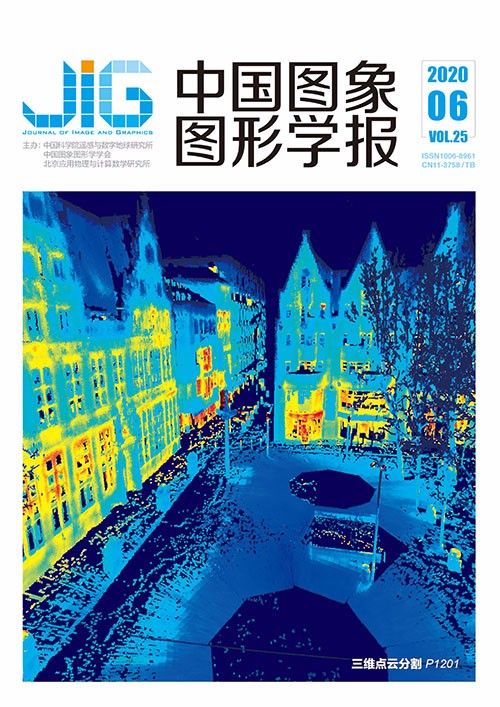
稳健局部特征非下采样小波域数字水印
摘 要
目的 基于数字水印技术的音乐作品版权保护是学术界的研究热点之一,多数数字音频水印方案仅仅能够对抗简单的常规信号处理,无法有效抵抗破坏性较强的一般性去同步攻击。为此,提出了一种基于稳健局部特征的非下采样小波域数字水印算法。方法 利用非下采样小波域平滑梯度检测算子从载体音频中提取稳定的音频特征点,结合数字音频样本响应确定局部特征音频段,采用量化调制策略将数字水印信号重复嵌入局部特征音频段中。结果 选取4段典型的采样频率为44.1 kHz、量化精度为16 bit、长度为15 s的单声道数字音频信号作为原始载体进行测试,并与经典算法在不可感知性和鲁棒性两方面进行对比。结果表明,本文算法在含水印音频与原始载体音频间的信噪比平均提升了5.7 dB,同时常规攻击和去同步攻击下的平均检测率分别保持在0.925和0.913,高于大多数传统算法,表明了本文算法具有较好的不可感知性。在常规信号处理(MP3压缩、重新量化、重新采样等)和去同步攻击(幅度缩放、随机剪切、音调伸缩、DA/AD转换、抖动等)方面均具有较好的鲁棒性。结论 本文利用描述能力强且性能稳定的平滑梯度刻画局部数字音频性质,提出一种基于平滑梯度的非下采样小波域音频特征点提取方法,有效解决了音频特征点稳定性差且分布极不均匀的缺点,提高了数字音频水印对音调伸缩、随机剪切、抖动等攻击的抵抗能力。
关键词
Digital watermarking algorithm in the UDWT domain based on robust local features
Niu Panpan1,2, Yang Siyu1, Shen Xin1, Yang Hongying1, Shi Qiliang1, Wang Xiangyang1(1.School of Computer and Information Technology, Liaoning Normal University, Dalian 116029, China;2.Faculty of Electronic Information and Electrical Engineering, Dalian University of Technology, Dalian 116023, China) Abstract
Objective Under the background of the continuously increasing quantity of digital documents transmitted over the Internet, efficient and practical data hiding techniques should be designed to protect intellectual property rights. Digital watermarking techniques have been historically used to ensure security in terms of ownership protection and tamper-proofing for various data formats, including images, audio, video, natural language processing software, and relational databases. This study focuses on audio watermarking. In general, digital audio watermarking refers to the technology of embedding useful data (watermark data) within a host audio without substantially degrading the perceptual quality of the host audio. For different purposes, audio watermarking can be divided into two classifications: robust and fragile audio watermarking. The former is used to protect ownership of digital audio. By contrast, the latter is used to authenticate digital audio, i.e., to ensure the integrity of digital audio. A digital watermarking scheme generally has three major properties: imperceptibility, robustness, and payload. Imperceptibility indicates that the watermarked audio is perceptually indistinguishable from the original one. This property is required to maintain the commercial value of audio data or the secrecy of embedded data. Robustness refers to the ability of a watermark to survive various attacks, such as JPEG/MP3 compression, additive noise, filtering, and amplification. Payload refers to the total amount of information that can be hidden within digital audio. Imperceptibility, robustness, and payload are three major requirements of any digital audio watermarking system to guarantee desired functionalities. However, a trade-off exists among them from the information-theoretic perspective. Simultaneously improving robustness, imperceptibility, and payload has been a challenge for digital audio watermarking algorithms. A digital audio watermarking scheme must be robust against various possible attacks. Attacks that attempt to destroy or invalidate watermarks can be classified into two types: noise-like common signal processing operations and desynchronization attacks. Desynchronization attacks are more difficult to address than other types of attacks. Designing a robust digital audio watermarking algorithm against desynchronization attacks is a challenging task. Method In this study, we propose a new second-generation digital audio watermarking in the undecimated discrete wavelet transform (UDWT) domain based on robust local audio features. First, robust audio feature points are detected by utilizing a smooth gradient. These feature points are always invariant to common signal processing operations and desynchronization attacks. Then, local digital audio segments, centering at the detected audio feature points, are extracted for watermarking use. Lastly, a watermark is embedded into local digital audio segments in the UDWT domain by modulating low-frequency coefficients. We use robust significant UDWT coefficients that can effectively capture important audio texture features to accurately locate watermark embedding/extraction position, even when under desynchronization attacks. Result To evaluate the performance of our scheme, watermark imperceptibility and robustness tests are conducted for the proposed watermarking algorithm. The watermark detection results of the proposed algorithm are compared with those of several state-of-the-art audio watermarking schemes against various attacks under equal conditions. All the audio signals in the test are music with 16 bit/sample, 44.1 kHz sample rates, and 15 s duration. All our experiments are executed on a personal computer with Intel Core i7-4790 CPU 3.60 GHz, 16 GB memory, and Microsoft Windows 7 Ultimate operating system. Moreover, MATLAB R2016a is used to perform the simulation experiments. To quantitatively evaluate the imperceptibility performance of the proposed watermarking algorithm, we also calculate signal-to-noise ratio (SNR), which is an objective criterion and always used to evaluate audio quality. The SNR of the proposed scheme is improved by 5.7 dB on average, demonstrating its effectiveness in terms of the invisibility of the watermark. Watermark robustness is measured as the correctly extracted percentage of extracted segments. The average detection rate remains at 0.925 and 0.913, which are higher than those of most traditional algorithms. Therefore, the experimental results show that the proposed approach exhibits good transparency and strong robustness against common audio processing activities, such as MP3 compression, resampling, and requantization. The scheme also demonstrates good robustness against desynchronization attacks, such as random cropping, pitch-scale modification, and jittering. Conclusion An audio watermarking algorithm based on robust feature points of the wavelet domain is proposed on the basis of audio content features and the stability of the low-frequency coefficient of UDWT. First, the original audio is dealt with using UDWT, and then by calculating the first-order gradient responses of the low-frequency coefficient, ranking these responses in descending order, and selecting the highest response as criterion to set the threshold. From these processes, stable and evenly distributed feature points are obtained. Then, the robust feature point is set for identification, and audio watermarking is embedded. Finally, the low-frequency coefficient is inserted into watermarking via quantization index modulation. The proposed scheme effectively solves the disadvantages of poor stability and uneven distribution of audio feature points, improving the resistance of digital audio watermarks to pitch-scale modification, random cropping, and jittering attacks.
Keywords
digital audio watermarking desynchronization attacks feature points smooth gradient undecimated discrete wavelet transform (UDWT)
|



 中国图象图形学报 │ 京ICP备05080539号-4 │ 本系统由
中国图象图形学报 │ 京ICP备05080539号-4 │ 本系统由